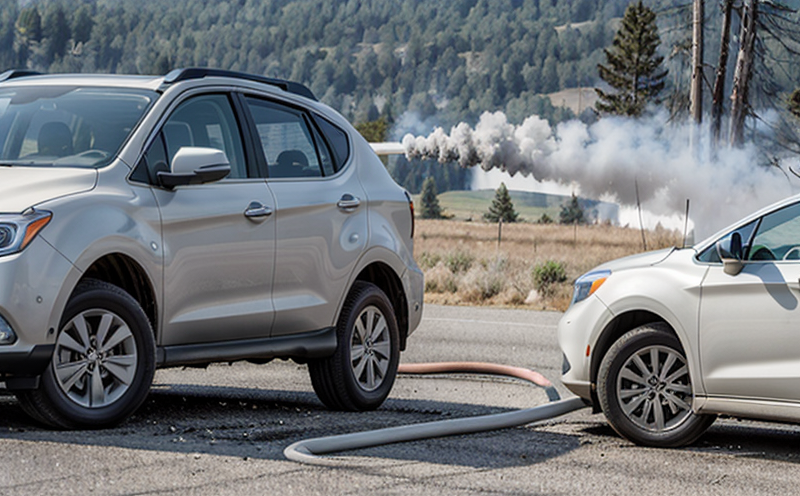Toxic Gas Emission Analysis During Material Combustion
In fire safety testing, understanding the behavior of materials under combustion conditions is critical to ensure public and occupational safety. One key aspect of this analysis involves assessing toxic gas emissions released during material combustion. This service focuses on providing detailed toxic gas emission analysis using state-of-the-art equipment and adhering to relevant international standards.
The process begins with selecting appropriate specimens that represent the materials under scrutiny. These could range from insulation foams, plastics used in building construction, synthetic fabrics for textiles, or any other combustible material of interest. Specimens are prepared by cutting them into uniform sizes suitable for the testing apparatus. The apparatus used is designed to simulate real-world combustion conditions while ensuring precise control over temperature and oxygen levels.
The test involves placing these specimens within a controlled environment where they undergo combustion. Sensors embedded in the system measure various parameters such as carbon monoxide (CO), nitrogen dioxide (NO2), hydrogen cyanide (HCN), and other potentially harmful gases released during the process. These sensors are calibrated according to international standards like ISO 13968, ensuring accuracy and reliability.
The collected data is then analyzed using sophisticated software that generates reports detailing the amounts of each toxic gas emitted per unit mass or volume burned. This information helps stakeholders make informed decisions about material selection for products intended for use in environments where fire risk exists. For instance, manufacturers can identify safer alternatives if their current materials exceed acceptable limits.
Understanding these emissions also aids in developing more efficient firefighting strategies by providing insights into how quickly certain types of fires might spread or what kinds of gases firefighters need protection against when responding to incidents involving specific materials.
This service plays an important role not only in ensuring compliance with regulations but also in promoting innovation within industries reliant on combustible materials. By offering comprehensive toxic gas emission analysis, we contribute towards safer working environments and better-informed product development processes across sectors like construction, automotive manufacturing, textiles, electronics assembly, among others.
Applied Standards
The testing procedures for measuring toxic gas emissions during material combustion adhere strictly to internationally recognized standards such as ISO 13968 and ASTM E662. These guidelines provide a framework ensuring consistency across different laboratories performing similar analyses globally.
- ISO 13968: This standard specifies methods for determining the flammability characteristics of plastics and other materials by measuring the amount of toxic gases produced when exposed to flame.
- ASTM E662: Provides procedures for measuring the evolution of various gases from solid or liquid materials when subjected to combustion.
The use of these standards ensures that our results are comparable with those obtained by other reputable laboratories worldwide, thereby enhancing credibility and trustworthiness within the industry. Compliance with such recognized protocols is essential in maintaining high ethical standards and contributing positively to regulatory compliance efforts.
Why Choose This Test
- Precision: Our laboratory uses cutting-edge instrumentation capable of detecting even trace amounts of toxic gases, ensuring precise measurements that align closely with international norms.
- Compliance Assurance: By adhering strictly to established standards like ISO 13968 and ASTM E662, we help clients ensure their products meet necessary regulatory requirements.
- Innovation Support: Understanding toxic gas emissions can guide material scientists towards developing safer alternatives or improving existing ones.
The ability to analyze the exact composition of gases produced during combustion allows us to identify potential hazards early on in product development cycles. This proactive approach enables companies to address issues before they become critical problems, saving time and resources while enhancing overall safety standards.
Competitive Advantage and Market Impact
By offering this specialized testing service, our clients gain significant competitive advantages. Firstly, it demonstrates their commitment to product safety and regulatory compliance, which is increasingly becoming a key factor for consumers when making purchasing decisions. Secondly, the insights gained from such tests can lead directly to innovations that set brands apart in crowded markets.
- Market Differentiation: Companies who invest in thorough toxic gas emission analysis not only comply with regulations but also differentiate themselves through superior safety features.
- Premium Positioning: Brands associated with rigorous testing are often perceived as premium offerings due to their dedication to quality and safety.
In terms of market impact, our service helps drive overall industry standards higher by encouraging competitors to follow suit. As more organizations adopt best practices in this area, it contributes positively towards creating safer products across various sectors including construction materials, automotive components, personal protective equipment (PPE), etc.





